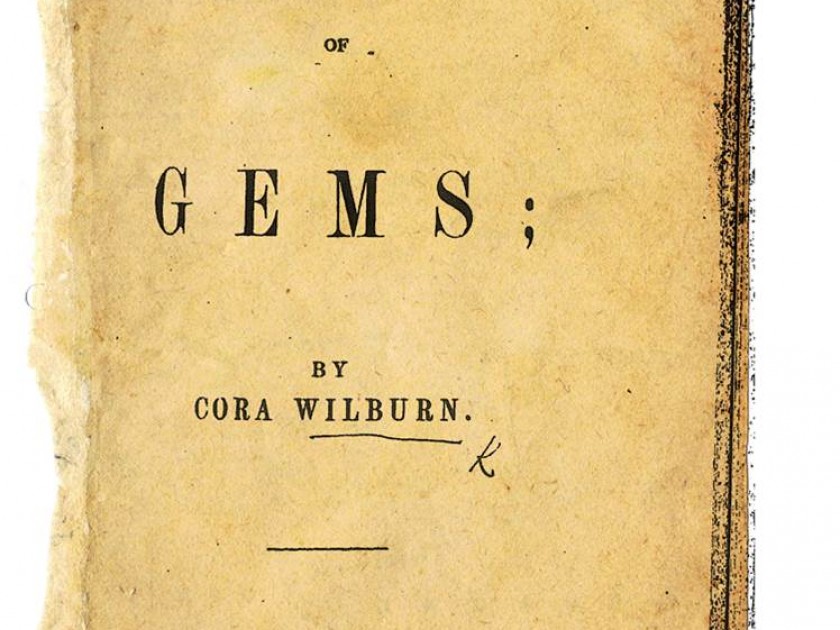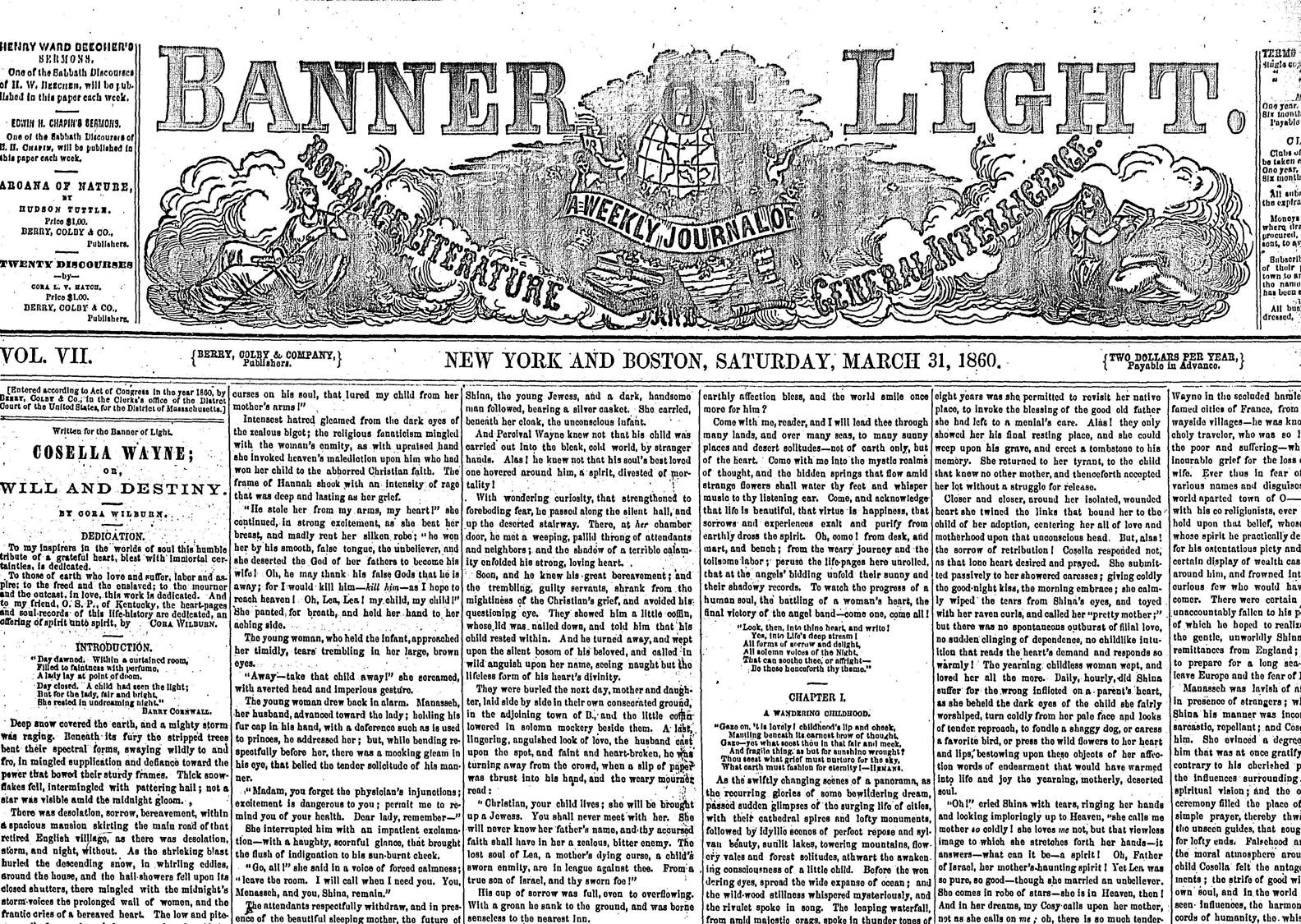
In a celebrated 1889 article published in The Chautauquan entitled “The Jews in the United States,” Philip Cowen, editor of the American Hebrew listed ten female ”Jewish writers of this country,” as part of a survey of Jewish worthies. He devoted most of his brief account to the recently deceased Emma Lazarus — the “sweet singer in Israel” — who died prematurely in 1887. He then proceeded to offer an incomplete list of living writers “of both verse and prose,” beginning with the Jewish communal leader and sometime author, Minnie Louis, and concluding with the not-yet-famous Henrietta Szold. All of the names on his list would today be familiar to scholars, except for one: Cora Wilburn.
I spent decades trying to solve the mystery of Cora Wilburn. I encountered her poems in various late nineteenth-century Jewish periodicals, such as The Menorah; I found an intriguing letter she wrote to a young Henrietta Szold extolling her “efforts in behalf of our unfortunate Jewish brethren of Russia;” I read the early twentieth-century writer and immigration rights activist Mary Antin’s account of a visit she made to Wilburn — “the most interesting woman I know, in many respects” — secluded in her old age, who had become, according to Antin, “a hater of the world and individuals.”
All of the names on his list would today be familiar to scholars, except for one: Cora Wilburn.
A breakthrough occurred when I read Ann Braude’s Radical Spirits, a history of Spiritualism and the women’s rights movement in nineteenth-century America. There I learned that Wilburn identified with the religious movement known as Spiritualism, and wrote extensively for Spiritualist publications, even as a Jew. Another breakthrough came when Brandeis University acquired the searchable online edition of the Boston Jewish Advocate. There I found an article-length biographical retrospect on Wilburn’s life and career, published in February 23, 1912. From that document, and from the many brief obituaries published upon Wilburn’s death in 1906, I sensed that there must be much more to her story.
The Israel Institute for Advanced Studies (IIAS) in Jerusalem enabled me to continue my search. In 2016 the IIAS invited me to join a group of scholars led by Professor Moshe Rosman that focused upon “Jewish Women’s Cultural Capital” across the ages. Two Brandeis students and I scoured the internet in advance of my trip (Wilburn’s unusual name facilitated our search). The question became, how much could we find online concerning her life and work?
The answer astonished me: hundreds of pages of small-print prose and poetry by Wilburn spread over a wide range of journals, most of them not Jewish, and extending over a half-century. The bulk of her articles had appeared in little-remembered Spiritualist journals that, much to my good fortune, had been uploaded to the internet by the International Association for the Preservation of Spiritualist and Occult Periodicals. I had no time to read all this material prior to departing, so I assembled it all in two large loose-leaf notebooks and sent it to the Israel Institute for Advanced Studies in Jerusalem.
Beginning in September 2016, and for many days thereafter, I sat in my office on the campus of Hebrew University and read Cora Wilburn’s writings chronologically, starting with her 1855 essay on “Free Love,” and continuing through fiction, non-fiction and poetry. In due course, I reached her serialized novel, Cosella Wayne, which began on the front page of the March 31st, 1860 issue of, The Banner of Light: A Weekly Journal of Romance Literature and General Intelligence.

The novel immediately captured my attention as its central characters were Jews. It soon dawned on me that nothing resembling this novel appears in the (meager) canon of nineteenth-century American Jewish fiction. Indeed, Cosella Wayne anticipates central themes of American Jewish writing: intermarriage, generational tension, family dysfunction, Jewish-Christian relations, immigration, poverty, the place of women in Jewish life, the rise of romantic love, and the tension between destiny and free will. The book provides rich descriptions of Jewish rituals as well as Jewish communities around the world, and it introduces readers to Jewish texts little available at that time in English, such as the Ethics of the Fathers. The story casts light on the early decades of Spiritualism — today appreciated for its openness toward women and advocacy for liberal political causes, such as abolitionism and women’s rights. Finally, Cosella Wayne dates back farther than any previously known Jewish novel published in the United States with an American themes.
Standard accounts consider Nathan Mayer’s Civil War novel, Differences, published in 1867, to be “the first novel of literary value to treat of American Jews seriously, realistically, and at length.”[1] Cosella Wayne, set in the 1840s and published in 1860, predates Differences by seven years. The first American Jewish novel authored by a woman, according to most accounts, is Emma Wolfe’s novel of intermarriage, Other Things Being Equal, published in 1892. Again, Cosella Wayne revises this chronology and demonstrates that the very first American Jewish novelist of consequence was another woman, Cora Wilburn.
Ultimately, I decided to publish selections from the Wilburn diary along with the novel, in the hope that readers would enjoy seeing for themselves how a novelist transforms the events of her own life into fiction.
The biographical article that I had found earlier concerning Cora Wilburn — published in the Jewish Advocate by a Boston rabbi named Menachem M. Eichler who knew her — included quotations from a diary that Wilburn kept. Might that diary survive, I wondered? I searched in all of the obvious places as well as some obscure ones — like local historical societies in Massachusetts and Rabbi Eichler’s Temple Ohabei Shalom in Boston — but without success. Then, I chanced upon a handwritten letter to historian Jacob Rader Marcus, founder of the American Jewish Archives in Cincinnati, from Sadie R. Cohen (d. 1959), widow of Judge A. K. Cohen of Boston. It thanked Marcus for letting her know that “the papers of the diary of Cora Wilburn have been received with the minutes of the Beth El Synagogue.” The diaries of little-known women, in those days, were not catalogued separately at the American Jewish Archives (or most other archival institutions), but archivist Kevin Proffitt, based on this clue, had no trouble locating the long overlooked item. “Found it!” he wrote to me in a gleeful email, and soon sent me a scanned copy.
Thanks to this diary, which covers the precise time period of the novel (1844−48) and was clearly its central source, I was able to fill in many blanks concerning Cora Wilburn, particularly her tumultuous life from age twenty to twenty-four, when both of her parents died and she immigrated alone to Philadelphia. Among other things, it helped me to confirm that her original first name was Henrietta. I later discovered that she immigrated to America under the family name “Jackson,” but her original family name was Pulfermacher. Ultimately, I decided to publish selections from the Wilburn diary along with the novel, in the hope that readers would enjoy seeing for themselves how a novelist transforms the events of her own life into fiction.
My introduction to Cosella Wayne contains a brief biography of Cora Wilburn. Based in part on her diary, it also utilizes hundreds of other pages of her writings, including autobiographical chapters and unpublished letters. But much more remains to be discovered. My hope is that others will pick up the trail of Coral Wilburn, publishing additional items from her oeuvre and learning more about her life. She deserves it, for she pioneered Jewish women’s writing in America, and, thanks to a half-century of literary productivity, produced more than any other American Jewish woman writer of her time.
[1] Louis Harap, The Image of the Jew in American Literature: From Early Republic to Mass Immigration (Philadelphia: Jewish Publication Society, 1974), 275.
Jonathan D. Sarna is the Joseph H. and Belle R. Braun Professor of American Jewish History at Brandeis University and directs its Schusterman Center for Israel Studies. He is also the chief historian of the National Museum of American Jewish History. He is author or editor of more than thirty books on American Jewish history and life including American Judaism: A History.